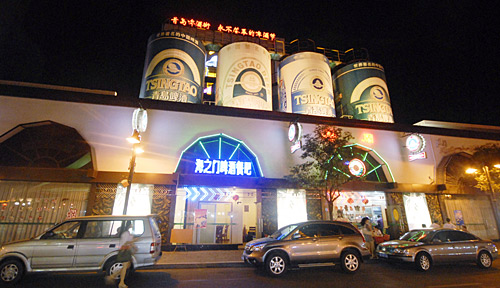|
 |
|
LARGER THAN LIFE: One bar on Beer Street in Qingdao is adorned with sculptures of Tsingtao Beer cans that decorate its roof (WEI YAO) |
Scenically located on a peninsula overlooking the Pacific Ocean, Qingdao is a coastal city soaked in two kinds of foam. One floats in atop the sea's waves while the other forms a frothy head at the top of mug. Both are beloved by millions.
Qingdao's Tsingtao Brewery, founded by German settlers in 1903, is one of China's oldest beer breweries. It is the only brewery in China that has been able to produce beer without interruption for over 100 years, defying two world wars, when invading armies occupied the city and the brewery changed hands several times.
The city's long history of making the bubbly beverage has left locals the most beer-obsessed population in China. Government statistics show that the city's per-capita beer consumption for 2007 was 150 liters, about five times that of the 27.6-liter-per-year national average.
Almost all beer consumed in Qingdao is Tsingtao Beer, the time-honored local brand, which was first produced for homesick German soldiers stationed in the city. It is common in the summer to see people carrying a plastic bag of beer on their way home, bought from roadside beer vendors ubiquitous throughout the city. A favorite summer dinner for residents consists of just beer and stir-fried seafood.
Beer lovers from across China who visit Qingdao rarely skip a visit to their Mecca, the Tsingtao Beer Museum, which is built on the brewery's original site. There is nowhere else in the city where tourists can lose their balance without even tasting a beer. Visitors can experience simulated drunkenness complete with hangover by walking through a tipsy room or see the oldest Siemens motor in China, which once drove the brewery's mixer for over 90 years. They also get to see posters, trademarks, advertisements and awards for Tsingtao Beer over the course of its development. The museum, which was launched by Tsingtao Brewery Co. Ltd. in 2003, displays the beer's strict quality standards, including a manual of production procedures compiled in 1964 that was mandated by the Central Government as the universal procedures of production in all of China's beer breweries.
When asked whether publicizing Tsingtao's production procedures gave its competitors an extra edge, Zhao Wenyuan, a public relations manager for the brewery, said that the beer's winning recipe includes its blue-blooded German beer yeast, which the first-generation brewers brought from Germany, along with the company's consistent use of more expensive imported malt from Canada and Australia. Zhao said farmers in these two countries have the tradition of planting malt in large areas, guaranteeing that the fermentation can turn malt of the same batch into the same taste, which is indispensable for making high-quality beer.
"The prudence and meticulousness of the German founders is in our company's blood," said Zhao.
Even after Tsingtao grew into a brewing giant with 53 breweries around China and 30,000 employees and was ranked the eighth largest beer producer in the world in 2007, Zhao said the company's top guidelines remain quality beer rather than sales volume. He said all of the breweries under the group company use exactly the same materials, equipment and production procedures to ensure the beer produced in different locations tastes exactly the same.
The brewery tour also enables tourists to observe a real beer-production line from behind the safety of glass windows, which is part of the Tsingtao experience. It produces 1,000 tons of beer per day. For most visitors, the most exciting part of the trip is to savor the draft beer fresh from the production line at the bars in the museum for free.
"I am excited to visit the museum since I have known this brand since back in the day when drinking beer, especially good beer like Tsingtao, was a luxury to ordinary people," said Liang Jianliang, a tourist sipping his at the bar affiliated with the museum. The diabetic oil company worker felt sad that he could not finish his glass, but he bought six bottles of souvenir beer at the museum store for his family and friends back in Jiangsu Province.
The consumption power of the Chinese people is growing and has strongly boosted the country's beer sales in the last few years. China's beer output grew 6 percent year on year to 20.5 million kiloliters in the first half of 2009, leading to the country's eighth straight title as the world's largest beer producer and consumer. This is great news for Tsingtao Brewery, the second largest beer producer in China, which sold more than 3 million kiloliters of beer in the first half of 2009, up 12.6 percent year on year.
| 